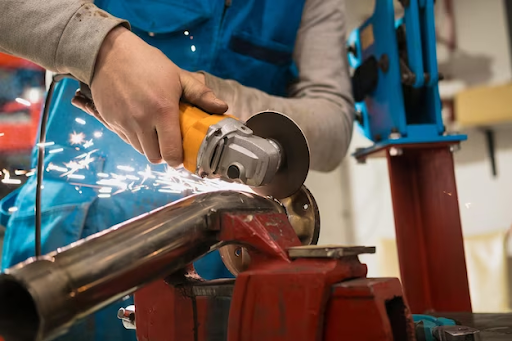The Art of Abrasion A Comprehensive Guide to Vitrified Grinding Wheels

Abrasion plays a crucial role in various industries, and one of the key tools in the realm of abrasive machining is the vitrified grinding wheel. These wheels have become indispensable in processes such as precision grinding, surface finishing, and tool sharpening. In this comprehensive guide, we delve into the art of abrasion, exploring the intricacies of vitrified grinding wheels, their composition, manufacturing processes, applications, and maintenance.
Understanding Vitrified Grinding Wheels
Vitrified grinding wheels, comprising abrasive grains, bonding material, and controlled porosity, form a robust structure crucial for abrasive machining. Through a meticulous manufacturing process involving mixing, molding, firing, and dressing, these wheels offer a reliable tool for precision grinding, tool sharpening, and surface finishing applications, showcasing their essential role in modern industrial processes.
A. Composition
Vitrified grinding wheels are composed of abrasive grains, bonding material, and porosity. The abrasive grains, often made of aluminum oxide or silicon carbide, provide the cutting action. The bonding material, typically glass-like in nature, binds the abrasive grains together, creating a rigid structure. Porosity is essential for coolant flow and chip evacuation during grinding.
B. Manufacturing Process
- Mixing The raw materials, including abrasive grains, bonding agents, and additives, are thoroughly mixed to achieve a homogenous blend.
- Molding The mixture is then shaped into the desired wheel form using molds or presses.
- The molded wheels undergo a high-temperature firing process, where the bonding material vitrifies, creating a strong and durable structure.
- The wheels are dressed to expose fresh abrasive grains and optimize performance.
Applications of Vitrified Grinding Wheels
Vitrified grinding wheels find indispensable roles across industries, excelling in precision grinding for aerospace and medical components, tool sharpening for maintaining cutting-edge efficiency, and surface finishing tasks for metals, ceramics, and composites. Their versatility and precision make them a go-to solution in critical applications, ranging from bearing manufacturing to achieving immaculate surface finishes.
A. Precision Grinding
Vitrified wheels are widely used in precision grinding applications where tight tolerances and surface finish are critical. Industries such as aerospace, automotive, and medical rely on these wheels for shaping and finishing high-precision components.
B. Tool Sharpening
Tools, including cutting tools and drills, often require precise sharpening to maintain their cutting effectiveness. Vitrified grinding wheels are ideal for this purpose, providing a consistent and sharp edge to tools.
C. Surface Finishing
The versatility of vitrified grinding wheels extends to surface finishing applications, where they are employed to achieve smooth and polished surfaces on materials such as metal, ceramics, and composites.
D. Bearing Manufacturing
Vitrified wheels are essential in the production of high-precision bearings. They enable the precise grinding of bearing components to meet stringent quality standards.
Advantages of Vitrified Grinding Wheels
Vitrified grinding wheels offer a compelling array of advantages, including exceptional wear resistance, heat resistance for high-speed operations, and a rigid structure ensuring precision and consistency. With versatility and longevity at their core, these wheels are the cornerstone in achieving high-quality results across diverse grinding applications.
A. High Wear Resistance
The vitrified bonding material contributes to the wheels’ high wear resistance, ensuring longevity and consistent performance over time.
B. Heat Resistance
Vitrified grinding wheels exhibit excellent heat resistance, making them suitable for high-speed grinding operations where heat generation is a concern.
C. Precision and Consistency
The rigid structure of vitrified wheels ensures precise and consistent grinding results, meeting the demanding requirements of various industries.
D. Versatility
These wheels are versatile and can be customized for specific applications, allowing for a wide range of grinding tasks.
Maintenance and Safety Considerations
Ensuring the longevity and safe operation of vitrified grinding wheels requires diligent maintenance. Regular dressing, truing, and balancing are imperative to sustain cutting efficiency and prevent vibrations. Adhering to strict safety protocols, including proper personal protective equipment and correct grinding techniques, is essential to mitigate risks and maintain a secure workplace environment.
A. Dressing and Truing
Regular dressing and truing of vitrified grinding wheels are essential to maintain their cutting efficiency. Dressing removes dull abrasive grains, exposing fresh ones, while truing restores the wheel’s shape.
B. Balancing
Proper balancing of grinding wheels is crucial to prevent vibrations and ensure smooth operation. Imbalanced wheels can lead to poor surface finish and even pose safety risks.
C. Safety Precautions
Users must adhere to safety guidelines, including wearing appropriate personal protective equipment, securing workpieces properly, and using the correct grinding techniques to minimize the risk of accidents.
Innovations in Vitrified Grinding Wheel Technology
Innovations in vitrified grinding wheel technology are revolutionizing abrasive machining. With advancements such as state-of-the-art bonding materials, nanotechnology-infused abrasives, and the rise of hybrid wheels, manufacturers are pushing the boundaries to deliver enhanced performance, durability, and precision in grinding applications. These innovations underscore the continuous evolution of vitrified grinding wheels in meeting the ever-growing demands of modern industrial processes.
A. Advanced Bonding Materials
Ongoing research has led to the development of advanced bonding materials that enhance the performance and durability of vitrified grinding wheels.
B. Nanotechnology in Abrasives
The integration of nanotechnology into abrasive grains has opened up new possibilities for achieving finer finishes and improved precision in grinding applications.
C. Hybrid Wheels
Hybrid wheels, combining vitrified and other bonding technologies, are emerging to address specific challenges in grinding, offering enhanced performance and versatility.
Conclusion
The art of abrasion embodied in vitrified grinding wheels continues to play a pivotal role in modern manufacturing and machining processes. From precision grinding to surface finishing, these wheels are indispensable in various industries. Understanding their composition, manufacturing processes, applications, and maintenance is crucial for maximizing their effectiveness and ensuring safety in the workplace. As technology advances, innovations in vitrified grinding wheel technology will likely continue, pushing the boundaries of what is achievable in the realm of abrasive machining.


